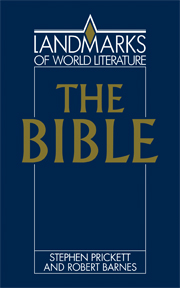5 - The Bible and literature
Published online by Cambridge University Press: 19 January 2010
Summary
Translation within the biblical tradition
As pointed out earlier, the Bible was from the first a palimpsest of languages and contexts. The Hebrew Bible did not evolve in a cultural vacuum, but as a sort of translation from and commentary (often in highly critical terms) upon the older literatures of Mesopotamia, Egypt, Canaan, and other parts of the Near East. After the return from the exile at the latest, it became necessary to follow readings from the Hebrew text with an ‘interpretation’ in Aramaic (this seems to be the point of Ezra 8:8), and from about the third century BC on these Aramaic ‘Targums’ came to be written down in continuous form. The surviving manuscripts of the Targums were transcribed between the seventh and the sixteenth centuries AD and certainly include some very late elements, but most scholars believe that they give a good general impression of Jewish understanding of the Bible at about the time of Jesus, if not much earlier. To get some idea of their importance, compare the following passage from a Targum of Isaiah 53 with any translation of the Hebrew:
Who has believed these tidings of ours, and to whom has the power of the mighty arm of the Lord been revealed? And the righteous will grow up before him like budding shoots; and as a tree that sends forth its roots by streams of water, so will the holy generations increase in the land that needed him: his appearance will not be that of a common man, nor the fear of him that of an ordinary man; but his countenance will be a holy countenance, so that all who see him will regard him earnestly.
- Type
- Chapter
- Information
- The Bible , pp. 109 - 138Publisher: Cambridge University PressPrint publication year: 1991
- 1
- Cited by



